Turns out that reboot is only 12 minutes from our apartment by bicycle. So tomorrow morning will be my first bona fide bicycle commute.
Regular readers may recall that I am not a huge fan of the way we educate our children. Partly (and maybe even mostly) this is because, although I was technically a “good student” throughout much of my own schooling, I didn’t actually end up learning very much. Everything I have learned, I’ve learned by doing it; while I recognize that some people are comfortable dwelling in the theoretical, I’m what you might call a “kinesthetic learner” — if I’m not mucking about inside something, I’m not learning.
While it’s too early to suss out the depths of Oliver’s learning style, all appearances are that he shares this trait with me to some degree (and with his mother, to boot).
Which explain, perhaps, why today was such a wonderful day for Oliver and I.
We were out on the streets of Copenhagen at 8:30 a.m. this morning. We caught bus 6A to the main station — about 10 minutes up the street — and from there took the 37 minute train ride to Lejre, home to the Lejre Forsøgscenter — the Lejre Experimental Centre.
From the train station in Lejre, a short ride on bus 233 took us to the door of the Centre. We were there by 10:30 a.m.
Now in this case “we” means me, Oliver, and about 100 school children who came along on the same train and bus with us. While I thought this would bode poorly for our experience, it turns out that there are a lot of acres to spread out into, and what we saw of our fellow travelers was entertaining and helpful rather than crowded:
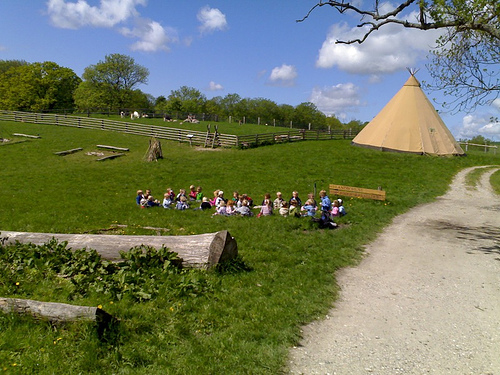
Now we’ve all been to those “ye olde historic village” places in our youth, haven’t we? Black Creek Pioneer Village. Orwell Corner. Upper Canada Village. And so on. The usual drill sees a cast of ye olde people dressed in ye olde costumes doing ye olde things for our education and amusement.
While there is a touch of this at Lejre — a weaver weaving, a potter potting — even these are done in a “no velvet ropes” kind of way. There is nowhere “off limits” at Lejre, no “fragile antiquities” that you can’t touch. It is truly a living museum.
What’s more, the heart of the Centre is a series of experiences that focus on teaching about the stone age and the iron age. And it is in this that the kinesthetic gloves come off and Lejre comes into its own.
We started our visit with a walk along the Karpesøen (Carp Lake) to the Historiske værksteder (Historic Workshops) where we had conversations with the aforementioned potter and weaver (I believe I may have convinced the weaver to try out the “sheep to shawl” concept so popular at Canadian agricultural exhibitions; she needs to learn how to spin first, though).
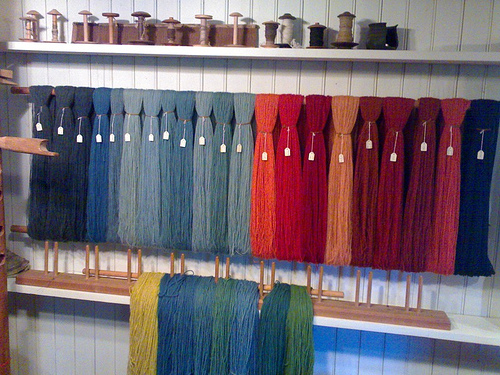
The weaver was housed in a thatched roof cottage — most of the buildings have thatched roofs, at least the “post-thatch” buildings — that was having its roof re-thatched. Watching that process alone was worth the visit: it’s a complex operation conducted by two men, and appears to essentially involve weaving a roof out of straw.
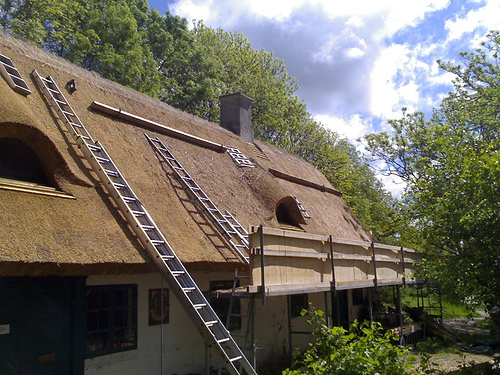
Around the corner and up the hill a bit we came upon a sounder of wild boar (yes, that’s what it’s called). Other than being borderline frightening in a “we have hidden powers and could storm through the fence and eat you” kind of way, the boars, especially the frolicsome baby boars, were delightful.
Up the hill a little bit more — by this time we’d integrated ourselves into a roving band of Icelandic senior citizens — we came upon a group of Canadian young people in residence as ye olde children in Landbohusene (Rural Cottages). They looked to be doing the country proud, churning butter, gathering water and chopping onions.
Back down the hill for lunch, we passed the frolicsome boar sounder mid-feeding, with an animated Dane conducting a session for a group of students about something I have only to assume involved boars and food.
Passing the Carp Lake again, we actually saw carp. They were very majestic looking fish.
It being 11:30 a.m. by now, and with only a train station croissant in our bellies, we stopped for lunch. Right in the middle of the Centre is a “Food Stand” that sells, among other things, very tasty smoked salmon and apple sandwiches and hot chocolate.
Sated, we headed over to the Filmsal (Cinema) to watch a Danish slide show about the aforementioned “heart” of the museum — a set of experiences set in a place called Båldalen (Fire Valley).
I must say that for an educational slide-tape presentation, they did pretty well: the presentation was mostly split-screen scenes with “modern life” illustrated on the left and the iron age equivalent illustrated on the right. So on the left you have kids playing video games and on the right you have iron age kid playing the flute. And so on.
After the show, it was down to the kinesthethesia.
Our first activity, ably guided by staff person Sara, was to take some wheat and turn it into flour. We did this by pounding. And pounding. And pounding. A rock against a bigger rock. As we were in a “between kindergarten classes” empty spell, we had the wheat pounding area to ourselves, and Oliver and I each had our own station. Because of my awesome strength and advanced years, I was able to best Oliver’s output; Oliver, however, had a much more entertaining style.
After wheat was turned into flour (and here I must admit that I had little idea how this process actually worked before pounding out the flour myself), we put it into a wooden bowl, added a little water, made a patty about the size of a hockey puck and placed it on an iron disk over a hot fire. In about three minutes we had ourselves a little hunk of unleavened bread. It was hot and crunchy and Oliver at the whole thing with enthusiasm.
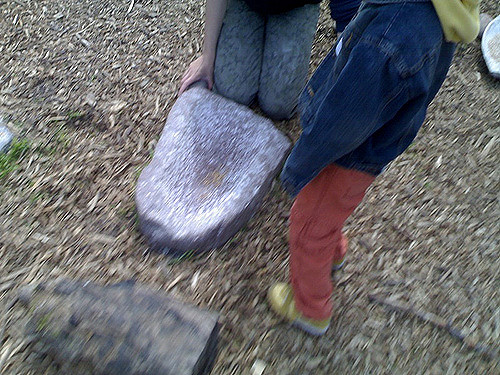
|
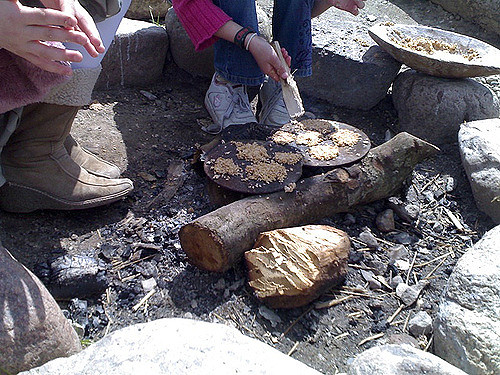
|
After making bread we headed over to the “chop wood with an iron axe” section and, after assurances from Sara that Oliver was quite old enough to participate, we each grabbed an iron axe, stood behind a log (with a helpful “safety log” between our legs and the target) and hacked away. Oliver got really good at it after a while; his Grandpa Joe will be proud of his new skill.
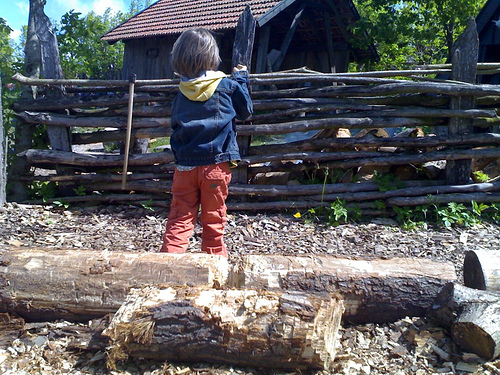
Next it was down to the dugouts. Oliver’s “small watercraft” experience to this point had been limited to the swan boats at Rainbow Valley; dugouts were something more of a challenge, especially given the “you can figure this out on your own just like they did in the iron age” ethos at play (albeit with a modern concession to lifejackets for everyone).
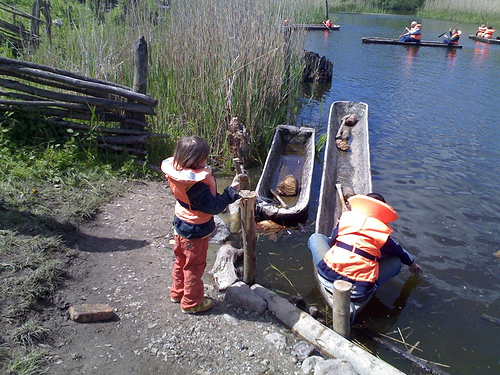
We ended up at opposite ends of a dugout that was about 20 feet long — a sort of super-dugout. Obviously my iron age ancestors didn’t weigh as much as I do: once I stepped into the boat there was about an inch of space between the lip and the water. But we managed to make it go, using our primitive iron age paddles to head out in the small pond, execute a turn or two, and make it back to shore in one piece.
Undrowned, we continued on. Next stop: the iron age.
The highlight of the iron age was the blacksmith. Oliver and I were sitting in a thatched roof iron age cottage having a discussion about what exactly the iron age was — iron better than stone for cutting, things made out of iron, etc. — when Oliver mentioned that horseshoes are made out of iron. At that exact moment a barefoot blacksmith bellowed in the door and said “I make horseshoes — want to see my shop?” We followed him:
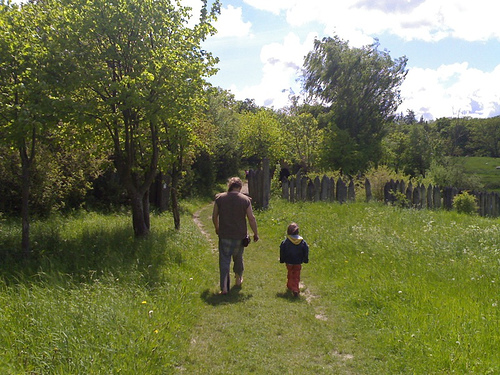
I have always found blacksmiths to be rather standoffish types. Or perhaps, because blacksmiths fall into that “type of guy to which Catherine is unnaturally attracted” category, perhaps I’m standoffish towards them. In any case, I’d never had a good one-on-one with a blacksmith until today. This guy knows his stuff and can talk and explain and hammer away and man the bellows and answer Oliver’s questions all at the same time.
You’d think, living with a metal-smith for 15 years as I have, that I would know more about how metal works. I suppose I simply forgot to ask. We sure learned a lot today. Like how you make charcoal (burn wood in an oxygen-reduced environment), where iron comes from (certain boggy situations produce rocks from which iron can be extracted), what colours iron glows with at various temperatures (white is 1200 degrees), that cast iron is very breakable, how to light a fire with flint, what bellows do. And more. We talked with the barefoot blacksmith for almost half an hour. And walked away with an intimate knowledge of his art.
There’s nothing like learning about the iron age while sitting in a thatched-roof, mud-coated blacksmith’s shop with a fire blazing at your feet and a barefoot blacksmith telling you tales.
After the iron age, we ventured on into the stone age. This era, because of its distance from the centre of the Centre, seemed lesser traveled, and we had vast expanses of pastoral stone age splendor to ourselves.
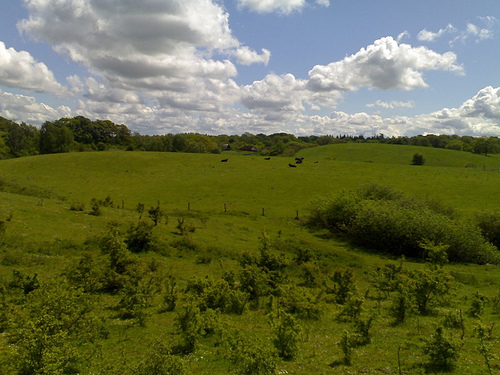
Okay, so maybe that’s not stone age splendor per se. But it certainly was beautiful countryside. When we got to the Stenalderbopladsen (Stone Age dwelling) we found a pre-thatch civilization:
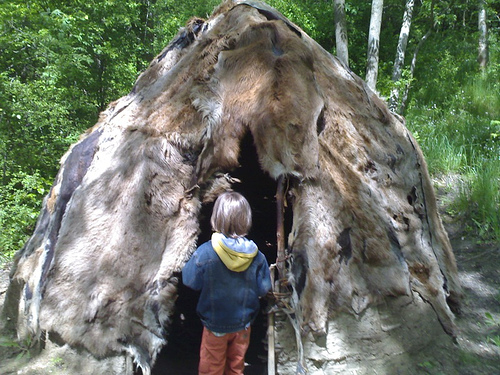
Having just learned about the wonders of iron, it was immediately obvious what not having iron left you without. Again, how would you ever understand this unless you’d just sat inside an iron age house and were now sitting in a more primitive skin-roofed dome with holes where the rain could get in”
From the stone age it was over a bridge to get back to the future. Why exactly it is that Oliver is afraid of mayonnaise, but not of rickety stone age bridges I do not know, but he bounded over this one like it was the most normal thing in the world:

From there it was over the hill, around the bend, over another bridge, through a sheep meadow, and we were back at the dugout milling chopping area. Oliver had a helpful conversation with Sara’s guiding partner about things like “what is harder, stone or iron?” (answer: stone) and “how do you light a fire?” (answer: “come on over here and we’ll light one together”). We took another whack or two with the axes, and then to finish final ride in the dugout (with my summer camp canoe skills coming back, we did much better):
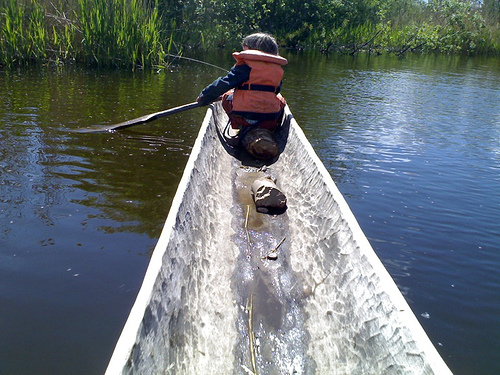
We said our goodbyes to our helpful guides, caught the 3:49 p.m. bus back to meet the 4:07 p.m. train back to Copenhagen, and were in our apartment by 5:30 p.m.
We found an apartment to rent right in the heart of Copenhagen because we wanted to have a quintessential urban experience; as it turns out, today we got a quintessential rural one too.
Does all this kinesthetic chopping and grinding and boating actually teach kids anything? When we got home we sat down to a dinner of cheese and tomato sandwiches on croissants. Oliver, in the way he often does, asked me “what croissants made of?” Then he stopped himself, got a twinkle in his eye, and said “that place - before - today - wheat!”.
My friend G. just sent word that Brian Cudmore, one of my favourite people, died this morning at 3:00 a.m.
Brian has been almost about to die so often over the last 5 years that I sort of got to believe that perhaps he would live forever: every time he was on death’s door, he made an amazing surprise recovery, and kept living. Alas, this time not.
Brian lives on, of course, through his son Chris, and daughters Cynthia and Carolyn; indeed in each of them you can see some of him.
I know they will miss him dearly. As will I. Good-bye, Brian.
Today’s mission: get the firmware on my Nokia N70 mobile phone upgraded. The “firmware” is really the software inside the phone — its guts, so to speak. And my phone guts dated back to October 2005 and many bug fixes and upgrades have been released since then, so it was time for a trip to the repair centre to have updated guts inserted.
The problem with owning a cool bleeding edge euro-phone like the N70 is that, because it hasn’t been released in Canada or the U.S. yet, you can’t actually get the firmware upgraded in North America. So this was my chance.
After some careful study of the Nokia Denmark website, I came across their locate a repair centre page and, from there, sent out a couple of email enquiries around town — “here’s what I need — can you help me?” — last night.
This morning I had two replies, and I choose one of them, from the Sonofon repair shop on Fredrikskaj, a location that appeared easy bicycle distance away.
I hitched up the bike (and figured out how to get on a bike that has a child seat attached — requires careful leaning) and headed south, rough directions printed out and in my pocket.
Fifteen minutes later I was inside the “Butik” at the gleaming Sonofon HQ (map) and found an extremely professional staff ready to help with the guts upgrade. They popped out my SIM card and my MMC card, took my name, told me it would take 30 minutes and cost me 250 kroner, and ushered me to the waiting room.
Thirty minutes later I had my phone back in hand, and the old “V 2.0539.1.2” firmware had been upgraded to “V 5.0609.2.0.1”. The tech apologized that he couldn’t install a Canadian firmware because one doesn’t exist; his compromise was to install the U.K. version, which was fine with me.
While I was there, I decided to up for a local SIM card; I’ve written a detailed guide to using a Sonofon prepaid SIM in the Rukapedia for anyone else who might want to go down the same path.
The only stumble this morning: I got really, really confused when I understood the Danish word øre to mean “euro”. I couldn’t for the life of me figure out how Danes could withstand mobile telephone rates of 80 EUR/minute. Øre, as it turns out, is what the Danish kroner is divided into 100 of — think “cents.”
As to the bike ride, I again experienced that sort of transcendental feeling I got last year when I rode in Copenhagen for the first time. There’s something so life affirming about being in a community of bicycle riders in a city that’s specifically tailored for your needs (bike lanes everywhere, special bike traffic lights, etc.). My only biking challenge was to get coordinated with the new (to me) combination of hand brakes and “back pedal to brake” bike I’m borrowing; the main pinch point is at intersections where, because you can’t back-pedal, you need to made sure the pedal is in a “take off” position when the light turns green.
When traveling in Europe, I’ve found ViaMichelin.com is the best site to use for web-based maps and routing. I’ve never given it an address it couldn’t find, in France, Portugal and Denmark. And it does route planning for car, walking and travel by bicycle.
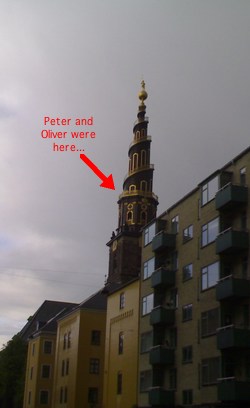 When I saw people walking around the spire of Vor Frelsers Kirke — The Church of Our Saviour — this afternoon, I just knew that Oliver and I had to climb up.
When I saw people walking around the spire of Vor Frelsers Kirke — The Church of Our Saviour — this afternoon, I just knew that Oliver and I had to climb up.
Catherine made it clear, back in 1998 when we were in Prague, that she would opt out of all “climb tall structure” travel activities — her knees just can’t take it — and this was the first time that a tall structure presented itself with Oliver old enough to climb it with me.
So we scrounged up 30 kroners from the bottom of the knapsack, paid the man at the bottom, and headed off up towards God.
God, I must tell you, lives very, very high up in the sky. Many, many stairs must be climbed. And some of the stairs have that precarious “scenario plan me tumbling to my death while Oliver looks on in horror” quality to them — windy stairs, steep stairs, cramped stairs.
Now for a guy so ready and willing to drag himself up tall structures, you would think I’d be pretty free of fear of heights. But, oddly (even to me), I am not.
So when, after 15 minutes of stair climbing, we reached the outdoor platform, I could feel the vertigo coursing through my veins. Fortunately I had Oliver to calm me — he would have happily continued on the additional slippery outdoor stairs to the very top of the spire if I’d let him, and was completely unaware of the whole “we’re up really, really high” quality of the expedition.
As it was we spent about 15 minutes at the top marveling at the view — as it turns out some of the only rain-free minutes of the day — and then made our way back down the stairs.

I’d do it again in a heartbeat — the stairs may have seemed precarious, but the church was build like a rock, and there was never any danger of everything going to hell (as it were).
I’m sure it will be the first of many tall structures that Oliver and I drag each other up.
One final image from Portugal. The public transit system around Porto is very integrated: under the andante brand name, metro, bus, tram and train are all part of the same RFID-based payment system. You purchase an andante card from an automated machine, and then “validate it” before you ride; it’s good for a certain amount of time for a certain number of zones (see this post to learn how we didn’t quite figure this out properly).
Another interesting aspect of the transit system is that every bus stop has a code printed on its sign, along with a telephone number. You send the code as an SMS text message with your mobile phone to the number, and a few seconds later you get back a return SMS with a list of the times the next buses stop there:

It works, and turned out to be really useful a couple of times.
Looked at from one perspective, our time here living in a little apartment in downtown Copenhagen is a sort of anthropological dig through modern day urban life. Yes, it’s only two weeks, but it’s amazing what you find out:
- When purchasing milk, the lighter the colour blue of the packaging, the lower the fat content.
- In France and Portugal I was (at 6 feet) always bumping my head when passing through doorways; I have no such problems here: Danes know how to make their doorways nice and tall.
- The showers here (assuming our apartment’s setup is common) have a “flow” dial and a “heat” dial. This makes so much practical sense: you just set your preferred heat level and leave it there, just turning on the “flow” every day when you want a shower.
- We’re learning a lot about living vertically. We’re on the fourth floor, and so getting in an out is all about stairs (lots of stairs), and looking out is all about your across the street neighbours — people you might never meet but otherwise have an intimate relationship with. Oh, and the rain passes by on it’s way down to the street. Neato.
- Food packaging is all Danish, all the time; while Danes speak impeccable English, they package in their native language. So as a unilingual English speaker, you might be buying sugar. Or perhaps it’s salt? Or freeze-dried hydrochloric acid?
- The hydrochloric acid problem is somewhat mitigated by the wonderful typography on the packaging; this place loves the sans serif.
- There is something called “DAB” radio here that appears to be digitally-transmitted radio over the air; the radio in the kitchen lists the “kbps” of stations it’s tuned to.
More as we dig further down.
You know those reality TV shows where cameras shoot a sort of “day in the life” of an airport? There’s one that’s shot at Heathrow that airs in Canada; every episode focuses on one or two little plots — someone trying to smuggle head cheese into the country, or a VIP flying in for the day, or a 12 hour delay on the flight to Australia. We’re taken “behind the scenes” and shown how the airport system deals with its everyday challenges.
Well, on Friday, flying through London Stansted, we became one of those stories; but for the lack of television cameras following us around, we’d have fit right into the exciting airport drama.
We had a six hour layover at Stansted. The first 3 hours were spent huddling against a wall on three “seen better days” chairs (Stansted’s pre-security areas are woefully lacking in chairs), having a little lunch, some fresh-squeezed juice from the juice bar, and generally trying to not perish from the exhaustion of already having woken up at 6:00 a.m. and flown in from Portugal.
Around 3:30 p.m. we were finally allowed to check in for our 6:15 p.m. easyJet flight to Copenhagen, and once we’d checked in, and loaded Oliver’s car seat through the oversized bagged chute, we went through security and headed over to Pret a Manger for some sushi.
Just as we were about finished up our lunch, Oliver started to rub his right eye. We didn’t pay attention for the first bit, but after he started complaining that his eye was hurting, Catherine took a closer look: turns out his eye was a little puffy, and looked like maybe he had something in it. I headed over to the washroom with him to see if we could wash his eye out; by the time we got there, his eye was very puffy, and surrounded by white puffy hives. A kindly baggage agent passing by noticed my obvious distress, and told us that if we tracked down a green-jacketed security guard, they could connect us with the airport’s medical team.
We stopped back to tell Catherine where we were headed, and then went off in search of the green jacketed.
While I’m certain that we saw many such green jacketed people on the way in, there were none at all in evidence as we walked around. We eventually came upon the “airline information” desk, and the clerk there let us borrow the telephone to call the emergency hotline (222 if you ever need it).
The emergency operator — presumably the same person you call if your plane is on fire or you’re having a heart attack — was very capable, took my details, and said she would dispatch a first aid officer shortly, and that we should stay where we were.
About 5 minutes later (it was probably 2 minutes, but felt like 5) said first aid officer — about the single most helpful man I’ve ever met in my life — was on the scene, looked at Oliver’s eye, and suggested we come in to the on-site medical clinic for an examination by a paramedic. He went off to fetch Catherine — by this time thinking the worst, of course — and then ferried us back through security (with promises to “fast track” us back the other way) and into a rabbit warren of little rooms behind an “airport personnel only” door.
And there in a little room that looked much like a doctor’s office, we found Peter the Scottish Paramedic, perhaps the second most helpful man I’ve ever met in my life. He gave Oliver a thorough going over — checked his airway, looked at his eye, listened to his breathing — and suggested that our best course of action would be to get some antihistamine from the airport pharmacy to see if that would help (the fact that Oliver was not otherwise in distress, and could breath normally, appeared to suggest he was not in imminent danger).
So while Catherine and Oliver stayed with Paramedic Pete, the first aid officer and I headed out into the airport to find the pharmacy.
When we arrived at the pharmacy the pharmacist was in the middle of some highly complex operation involving sticky tape. It turns out that the customer ahead of us was ordering what looked like a lifetime supply of some medicine or another, the label printer was broken, and the pharmacist was forced to hand-make and hand-apply individual labels on about 25 little boxes.
Reasoning that if I flipped out I would lose the support of the helpful first aid man (and the pharmacist), I calmly waited for 15 minutes while the sticky tape was applied. When this operation was over, the pharmacist listened to our tale, and immediately pulled a bottle of Piriton syrup from the shelf and told me how to dose it.
Then it was back to the rabbit warren to check on Oliver and give him the healing solution. By the time we returned his eye puff had subsided considerably, and the around-the-eye hives were gone. Catherine and Paramedic Pete, meanwhile, had deduced the likely source of the puffiness: the fresh squeezed orange juice Oliver had consumed earlier in the day. Apparently this was the 3rd or 4th report the paramedic had handled that could be traced back to the same retailer’s juice; his assumption was that some sort of spore or fungus on the orange was the culprit. He immediately placed a call to the juice place to warn them.
With a dose of Piriton in his belly (and a warning that it would knock him out — which it never did), we were indeed fast tracked back through security, huffed our way to the train to the gate, and as we came up the escalator the “passengers traveling with small children” announcement for our flight came over the PA.
Oliver was quite happy and normal by this point, and over the last 36 hours his eye has gradually returned to its normal state.
While the situation turned out to be not-so-serious, I still wouldn’t wish it on anyone. That said, it was nice to know that a team was waiting behind the scenes ready to deal with all that life could throw at the airport. Our heartfelt thanks go out to Paramedic Pete and nameless helpful first aid man (who turned out to be also responsible for elevators and myriad other airport quirks).
Oliver, of course, is never going to eat or drink another thing if I have any say in the matter.
By my calculation, I have spent about three months away from Prince Edward Island, in small and large gaps, over the last year. I’ve traveled more, and to more places, and for longer periods, than ever before in my life. It’s been great.
And one of the things I’ve learned is that the very act of moving about the planet, no matter how smoothly things go is inherently stressful. Because we’re not really programmed to move faster than our own feet can carry us, I assume that there must simply be built-in incompatibilities between human nature and, say, hopping across the Atlantic in six hours, or traveling from Portugal to Denmark in a day.
This isn’t about jet lag — at least not entirely — because north-south travel seems equally stressful. I think it’s the stresses of moving around so quickly, with so little control over the conditions, inside complex apparatus known to suddenly explode and dealing simultaneously with so many little worries — did I forget my passport? what if they find drugs in my pocket? what if the bus doesn’t stop where we’re supposed to get off? will I be able to understand road signs in Danish?
Regardless, travel takes it out of you.
And so we’ve come to understand that the post-rapid-travel day is necessarily set aside as the “get up late, take things easy, remember to eat, and don’t get ambitious” day. Sometimes we pull this off, sometimes we don’t.
Today we started well, stumbled, and the made an excellent recovery.
None of us were up until 10, and we phased into full operations mode slowly. So far so good. Our fatal flaw was — and isn’t it always? — after a late breakfast, thinking that we could just ignore lunch: around 1:30 p.m. we set out to see a little of the core of Copenhagen on three half-empty stomachs.
We quickly faded, and as we faded our ability to figure out just how to eat faded too. And so by 2:30 p.m. we were in the centre of the city, hungry and catatonic and wondering just what to do. Fortunately my “oh, I’ve already been to Copenhagen!” auto-pilot kicked in, and we were able to find our way to the good old shwarma place over near city hall. Thirty minutes later, we were fueled and happy. Isn’t eating amazing!
We spent the balance of the afternoon rambling around, Catherine taking picture of interesting gargoyles and me simply happy to be back in a city I got to know and love last June.
In the late afternoon, Olle rang in with news that he and Luisa were available for supper. Practical negotiations ensued and the decision was made to rendezvous at our place for a cooperatively constructed meal.
Regular readers will recall that I met Olle last year at reboot when he came up to me and said “hey, you’re Peter Rukavina.” Who could turn down an opening line like that? After hanging out at reboot, we’ve stayed in touch over the year digitally, conspiring and cooperating as opportunity arose, and my return trip this year with family in tow was, in no small way, designed to allow for some non-digital time with Olle, to let him get to know Oliver and Catherine, and to meet his [then fiance, now wife] Luisa.
It is always slightly intimidating to meet the partner of someone you’ve known for a while. What if they don’t like me? What if I don’t like them? What if the friend I know solo becomes odd and different when in combo? Fortunately for us, in Olle and Luisa’s case, any worries I might have had were without any basis. It is immediately obvious that they are sensationally compatible and complementary, and we found them delightful dinner guests.
And they were both very kind to, and respectful of Oliver, which goes a long, long way in my books.
And so Catherine and Luisa went out to scare up some food, we cooked up a stir fry, Olle went out and finagled some wine, and we sat down to the first of what I hope will be many happy dinners around the table here at Oehlenschlægersgade 5.
 I am
I am